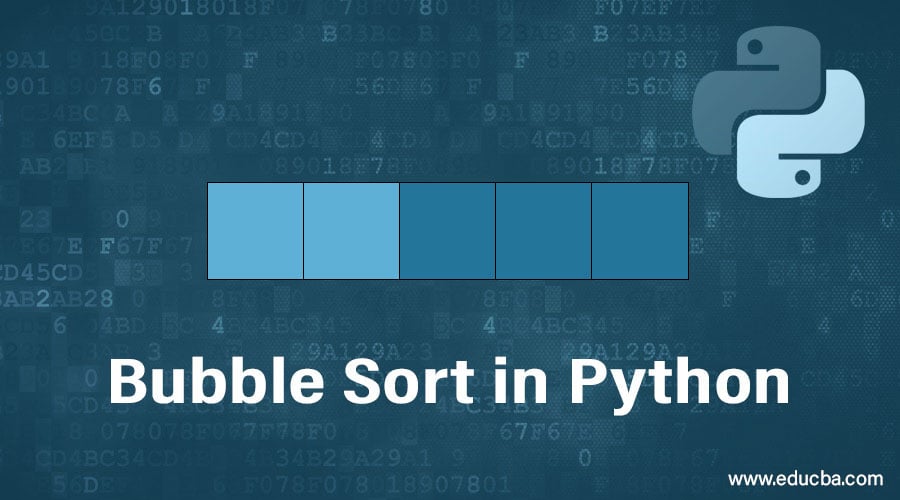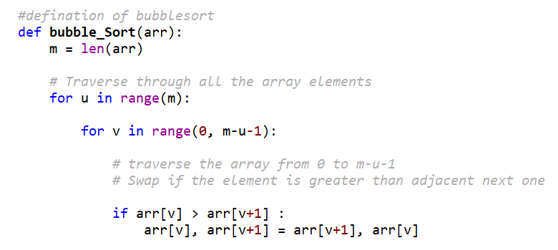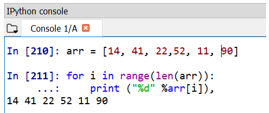Updated April 17, 2023

Introduction to Bubble Sort in Python
A python is a well-known object-oriented programming language used for the development of web-based applications or websites. Bubble sort is one of the data structuring algorithmic concepts, which can be incorporated in python programs for the purpose of sorting the data/ elements in an effortless, rational, and recurring exchange of the order of the data/ elements in the queue structure. However, this type of sorting data structure method is often not preferred due to its lower efficiency, as the sorting process is repeated until the faultless order is reached.
Example of Bubble Sort in Python
Let’s see it through an example:
First Run
(6 1 4 3) -> (1 6 4 2): Here 1st two elements get swapped if the order is not correct.
(1 6 4 2) -> (1 4 6 2): Here, the next two elements get swapped if the order is not correct.
(1 4 6 2) -> (1 4 2 6): Here, the next two elements get swapped if the order is not correct.
Second Run
(1 4 2 6)-> (1 4 2 6): Here 1st two elements get compared but don’t swap as the order is correct.
(1 4 2 6)-> (1 2 4 6): Here, the next two elements get swapped, as the order was not correct.
(1 2 4 6) -> (1 2 4 6): Here last two elements get compared but didn’t swap as the order is
Now we know the array looks sorted; however, one run is required without any swap to the algorithm to know if sorting is done.
Third Run
(1 2 4 6) -> (1 2 4 6) : No swap in1st two elements.
(1 2 4 6) -> (1 2 4 6): No swap in next two elements.
(1 2 4 6) -> (1 2 4 6) : No swap in last two elements.
As no swaps occurred at any stage, now the algorithm understands sorting is perfect.
Bubble sort has got its name because elements move up into the correct order, which is like bubbles rising to the surface.
Bubble sort in Python Language
Now let’s see the logical implementation of bubble sort through Python. Python is a very widely used language these days. Understanding it through Python will surely give you the confidence to be able to write it in any other language as well.
Python Code:
def bubble_Sort(arr):
m = len(arr)
# Traverse through all the array elements
for u in range(m):
for v in range(0, m-u-1):
# traverse the array from 0 to m-u-1
# Swap if the element is greater than adjacent next one
if arr[v] > arr[v+1] :
arr[v], arr[v+1] = arr[v+1], arr[v]To print array after bubble sort, you need to follow code:
for i in range(len(arr)):
print("%d" %arr[i]),
#Here arr will be your array.Explanation of Python code:
Here “m” is the length of the array. Two for loops hold the actual ground logic, where “u” represents the first element while “v” represents the second with which the first element has to compared for swapping if the sort order between both is not correct.
“arr[v] > arr[v+1]” represents the comparison of consecutive elements, if the first element is greater than the second element, exchange operation will be performed by the following expression:
That is “arr[v], arr[v+1] = arr[v+1], arr[v]”.
This exchange operation is called swap. The good part is no temporary memory is required for this kind of swap operation.
“u” represents the loop of every run, while “v” represents the stages of every stage. An example in the above section can be referred to.
After performing bubble sort, one can see the sorted array, with the code mentioned below:
for i in range(len(arr)):
print ("%d" %arr[i]),Let’s see how this behaves in Python IDE for a deeper understanding:
Output:
There are a few facts about Bubble Sort, which everyone should know before implementing it:
- A bubble sort is often considered as a not good efficient sorting method. As it has to exchange the items until its final location is known. This all leads to wastage of operations and hence very costly. This algorithm passes through each and every element, where sorting required or not required. Once the run passes without any swap, bubble sort is considered as completed.
- This is the simplest among all data structures; for any beginner, this gives good confidence. It’s easy to construct and understand.
- It uses a lot of time and memory.
- This is considered a stable algorithm, as it preserves the relative order of elements.
- Considered good for a small array/list. However, it’s a bad idea to use it for long ones.
Conclusion
Going through the above content of bubble sort, one could have got a crystal clear understanding of this sorting algorithm, specialized with python. Once one gets comfortable with the logic of bubble sort, understanding the other set of data structures will then be easier. A logical approach is the only way to excel in the field of data structure. Understanding first the logic of the data structure algorithm at every stage and then targeting its code through Python or in any other language should be the way.
Recommended Articles
We hope that this EDUCBA information on “Bubble Sort in Python” was beneficial to you. You can view EDUCBA’s recommended articles for more information.



